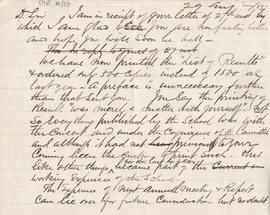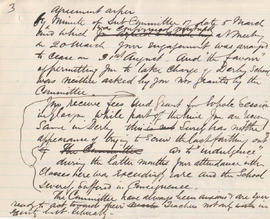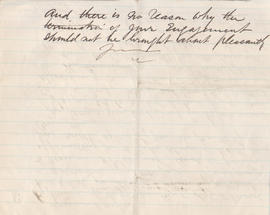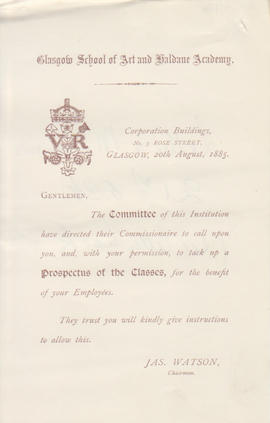Key Information
Reference code
Title
Date(s)
- c1846-2018 (Creation)
Level of description
Subfonds
Extent
35.35 metres plus 55 boxes of uncatalogued material
Content and Structure
Scope and content
Correspondence and Working Papers of the Directors of the Glasgow School of Art from 1846 to the present day. Material from DIR/14 onwards is currently uncatalogued and therefore not accessible for researchers. Papers are arranged by Director into the sub-series below, and each sub-series is catalogued in further detail: DIR/1: Henry MacManus, Headmaster from 1844-1848 DIR/2: Charles Heath Wilson, Headmaster from 1849-1863 DIR/3: Robert Greenlees, Headmaster from 1863-1881 DIR/4: Thomas C Simmonds, Headmaster from 1881-1885 DIR/5: Francis H Newbery, Director from 1885-1918 DIR/6: John Henderson, Director from 1918-1924 DIR/7: John D Revel, Director from 1925-1932 DIR/8: James Gray, Interim Director from 1932-1933 DIR/9: William Oliphant Hutchison, Director from 1933-1943 DIR/10: Allan Walton, Director from 1943-1945 DIR/11: Henry Y Allison, Interim Director from 1945-1946 DIR/12: Douglas Percy Bliss, Director from 1946-1964 DIR/13: Harry Jefferson Barnes, Director from 1964-1980
Appraisal, destruction and scheduling
This material has been appraised in line with Glasgow School of Art Archives and Collections standard procedures.
Accruals
System of arrangement
The records are arranged in series with one for each director.
General Information
Name of creator
Biographical history
Robert Greenlees, 1820-1894, had been a pupil teacher at the The Glasgow School of Art, a position which required the winning of a bronze medal. A small stipend was offered and the pupil divided his time between his own work, and teaching drawing in the elementary classes. Greenlees had progressed through the various grades of attainment on the national curriculum and was awarded an Art Master's certificate on the basis of his accumulated subject passes.
In 1863, he was appointed headmaster at The Glasgow School of Art, after Heath Wilson's retirement. He held this post from 1863-1881, and oversaw the move in 1869 from Ingram Street to the Corporation Buildings on Sauchiehall Street, with the main entrance to the School being 3 Rose Street. Greenlees was a founder member of the Glasgow Art Club, and served as president from 1882-1883.
Greenlees worked as a stained glass artist and later as a landscape painter, working primarily in oil and watercolour. He was an early member of the West of Scotland Academy, and a founder member of the Royal Society of Watercolour Painters in Scotland. He specialised in West Highland subjects, typically woodland scenes with birch trees growing out of a carpet of ferns. His technical skill was impressive and he ranks as a very competent landscape painter. As a supporter of life classes for women he employed women teachers at the School. His own daughter, Georgina, was one of the four female teachers employed.
Name of creator
Biographical history
Douglas Percy Bliss was born on 28 January 1900 in Karachi, India. He was educated at Watson's College, Edinburgh, 1912-1918, and at Edinburgh University, 1918-1922. He studied painting at the RCA under Sir William Rothenstein, 1922-1925, receiving an Associateship. From 1932 Bliss was a part-time tutor at the Hornsey School of Art and then at the Blackheath School of Art. During the Second World War he served in the RAF, at one point being posted to Scotland.
He was Director of Glasgow School of Art from 1946 to 1964 and under his guidance the School saw a re-emergence of the importance of design and the creation of the three new or reconstituted departments of Interior, Textile, and Industrial Design, raising them to the status of Diploma subjects, and providing them with fully equipped workshops. He strove to bring figures from London to teach, and those that came to Glasgow included Gilbert Spencer (formerly of the RCA and the brother of Stanley Spencer) and Eric Horstmann. Whilst in Glasgow he worked to save the Mackintosh tea-rooms, enlisting people such as Nikolaus Pevsner and John Betjeman to support the campaign and he was tireless in encouraging critical appreciation of the city's architecture. When Bliss left Glasgow School of Art in 1964 the School was listed in Whitaker's Almanac as among the six highest-ranking Art Schools in Britain.
Bliss was well known as a wood engraver and as a historian of wood engraving, although he was also known as a painter of watercolour landscapes. He selected and engraved Border Ballads for Oxford University Press in 1925 and wrote his History of Wood Engraving in 1928. He also illustrated many books throughout his lifetime before returning to painting watercolours in the 1980s. He was elected a member of the SWE 1934, and RBA 1939. He retired to Windley Cottage near Derby and was soon invited to become a Governor of the local art college, Derby School of Art. Bliss died on 11 March 1984.
Name of creator
Biographical history
Thomas Simmonds, 1842-1912, had been a teacher of Science and Art subjects at Derby School of Art, before taking over from Robert Greenlees as Headmaster at Glasgow School of Art in 1881. He seems to have been on the staff at Cheltenham School of Art early in his career, and may also have spent time teaching at the Birmingham Schools. Simmonds was very businesslike and his career suggests he was a good Headmaster in a managerial sense. Whilst at Glasgow School of Art he was instrumental in convincing the governors of the need for a new building, and regularly complained to the committee of management about the conditions that the students had to work under. He also attempted, unsuccessfully, to promote links between Glasgow School of Art and the Woollen College, a small independent textiles college. In 1885, he returned to Derby School of Art to take up the position of Headmaster. He had arranged to take up this position by April 1885, leaving Glasgow School of Art in May 1885, but his contract was not supposed to end until August 1885. This, plus the attempts by Simmonds to claim all monies he saw as due to him from student successes at the Science and Art examinations in South Kensington, led to an embittered correspondence between himself and the School. The letters that survive from this period illustrate the problems and financial fragility of the position of the headmaster of a provincial School of Design.
Name of creator
Biographical history
Henry MacManus, 1810-1878, art teacher and artist, was born in County Monaghan, Ireland. He worked in London from 1837-1844 and was a Head Teacher at Somerset House, London before being appointed Headmaster at the new Glasgow School of Design in 1844. The School was based at 16 Ingram Street and had accommodation for 500 pupils. MacManus started off on a high note, winning the confidence of the governors, who recommended him for a salary increase the next year. However he resigned in 1848 due to problems with the committee of management and returned to Dublin to become Headmaster of the Dublin School of Art, a position he held with great success until 1862. His departure from Glasgow became something of a cause celebre in the local press and art magazines, as Charles Heath Wilson, the man responsible for the report cited as the reason for MacManus leaving, became the subsequent Headmaster. MacManus, a painter, exhibited at the Royal Hibernian Academy, eventually being made the Honorary Professor of Painting there. He also exhibited at the Royal Academy, 1839-1841, British Institute and the OWS. He painted historical scenes and scenes of Irish life. He also worked as a book illustrator.
Name of creator
Biographical history
Charles Heath Wilson, art teacher and author, eldest son of Andrew Wilson, the landscape-painter, was born in London in September 1809. He studied art under his father, and in 1826 accompanied him to Italy. After seven years, he returned to Edinburgh, where he practised as an architect, and was for some time teacher of ornament and design in the School of Art.While in Edinburgh he wrote and published, in collaboration with William Dyce, a pamphlet (addressed to Lord Meadowbank) upon "The Best Means of ameliorating the Arts and Manufactures of Scotland," which attracted much attention. Shortly afterwards Dyce was made director and secretary of the recently established schools of art at Somerset House, but resigned in 1843, and Wilson, who had meanwhile been director of the Edinburgh school, was appointed his successor. His position there was not much more comfortable than Dyce's had been, and in 1848 he also resigned.In 1840 he had visited the continent to make a report to government on fresco-painting, and while in Glasgow he was occupied for nearly ten years under the Board of Trade in superintending the filling of the windows of Glasgow Cathedral with Munich pictures in coloured glass. He selected the subjects and wrote a description of the work (prefaced by some account of the process), which went through many editions. In January 1849 he became the second Headmaster of the new Glasgow School of Design. The School underwent many changes during Wilson's period of tenure, with the introduction of life classes, aand a mechanical and architectural drawing class. Wilson taught a class on practical geometry, and superintended the advanced class. The courses of study were modified to retain established designers and pattern drawers in the School. In 1853, with the creation of the Science and Art Department, the Glasgow School of Design became the Glasgow School of Art. In 1864 the Board of Trade masterships were suppressed and Wilson was pensioned, but continued his involvement with the School of Art for some years longer. He stayed in Glasgow, doing architectural work, and is listed as an Honorary Director of the School, and one of the Haldane Academy Trustees. He also gave evidence to several Commons Select Commitees, and prepared a report for the Commission on the Design of the National Gallery. In 1869 he and his family finally left Scotland and settled at Florence, where he became the life and centre of a large literary and artistic circle. He was much interested in Italian art, on which he wrote occasionally, particularly Michael Angelo. He had, for these and other services, the cross of the "Corona d'Italia" conferred upon him by Victor Emmanuel.He died at Florence on 3 July 1882.
Name of creator
Biographical history
Francis Henry Newbery, known as Fra. Newbery, was the Headmaster and Director of the Glasgow School of Art from 1885 to 1918. During that time the profile of the School was raised from that of a moderately successful institution to one an international reputation.
Newbery was born on 15 May 1855 in Membury, East Devon. He grew up in Dorset and studied as an Art Master in Bridport, before moving to London in 1875 to continue working as an Art Master there. In 1877 he started attending the National Art Training School at South Kensington where he was taught by Edward Poynter and other artists of the time. By 1885 he had taught in most of the School's classes and, at the age of 30, was appointed to the post of Headmaster of Glasgow School of Art.
His success at Glasgow School of Art was led by the acclaim and notoriety surrounding the work of designers and artists such as Charles Rennie Mackintosh, Margaret Macdonald, Frances Macdonald, Herbert McNair, Jessie M. King and others working in the 1890s in Glasgow. It was most highly acclaimed at the Turin Exhibition of Decorative Art, 1902. Much of this success was due to Newbery who selected the work and chose Mackintosh to design the rooms for its display. For this work Newbery was awarded an Italian knighthood.
Newbery oversaw the erection of the new School building at 167 Renfrew Street. He had drawn up the brief, based on his own personal experience and the demanding Department of Science and Art specifications, and he appreciated Mackintosh's design for its practical interpretation. In favouring Mackintosh's plans, he was supported by the Governors of Glasgow School of Art and the official Department of Science and Art advisors.
Under the Scottish Education Department in 1901, Newbery devised his own curriculum which led to the award of a Diploma. The course was divided into four stages, which did not necessarily correspond to years - students were moved through at their own pace, some taking seven or eight years and others only three. Many were not ever awarded the Diploma.
Staff brought in by Newbery to teach at the School included, among others, the Belgian Symbolist painter Jean Delville, the English portraitist, Maurice Greiffenhagen, the French Adolphe Giraldon, the English Decorative artists W.E.F. Britten and Robert Anning Bell and, as Head of Architecture, the French architect Eugene Bourdon. There was also a strong core of Glasgow School of Art trained teachers including Jessie Newbery, Anne Macbeth, Dorothy Carleton Smyth, Olive Carleton Smyth, Allan D. Mainds, James Gray and de Courcy Lewthwaite Dewar.
Newbery inaugurated many schemes at the School including the Glasgow School of Art Club and the Artist Teachers' Exhibition Society, both of which encouraged exhibitions and competition within the School, and allowed present and former staff and students to meet. He invited leading figures in the art and design worlds to lecture at the School including Walter Crane, C.F.A. Voysey, William Morris and Lewis F. Day. He established good contacts with Glasgow University so that the students received lectures in anatomy, art history, philosophy and literature, beyond those available within the School.
Newbery exhibited with the Glasgow Boys, and had close ties to John Lavery, James Guthrie and E.A. Walton. His paintings were exhibited world-wide and he was particularly successful in Italy. From 1890, most of his holidays were spent in Walberswick, Suffolk, often in the company of other Scottish artists, such as Mackintosh and the young W.O. Hutchison.
In 1918 he was granted early retirement on medical grounds, and moved to Corfe Castle, Dorset where he continued to paint, mainly in the field of public art. He died at the age of ninety-one on 18 December 1946. Jessie Newbery died sixteen months later.
Name of creator
Biographical history
John Henderson (1860-1924), son of Joseph Henderson, painter (1832-1908), was born in Glasgow in 1860. He studied at the Glasgow School of Art under Robert Greenlees and then took an MA at Glasgow University. Henderson was a landscape and portrait painter and first exhibited at the Royal Glasgow Institute in 1884. He was a member of the Council of the RGI, assisted at the Glasgow International Exhibitions of 1901-1911 and was a Governor at GSA from 1906-1918. He was appointed director of GSA in 1918, initially on a temporary basis (he had been acting director in 1914 when Newbery was ill). He seems to have had good links with staff and students (see DIR 6/3). His father and brother, both called Joseph Henderson, were also Governors of GSA.
Under his directorship the School formed stronger links with the University, and the Architecture Degree Course was introduced in 1924, leading to the School being recognised as a university teaching institution. He was involved in art education for Secondary Schools. He died suddenly in 1925.
Name of creator
Biographical history
John D Revel was born in Dundee in 1884. He studied at Dundee School of Art, becoming an Art Pupil Teacher. After qualifying as a teacher he taught for two years in Shipley, Yorkshire before becoming the Principal Teacher of architecture in Preston, Lancashire. In 1906 he gained an open Scholarship to the RCA and in 1911 left the College with a degree in architecture, a degree in painting and the award of a travelling Scholarship for painting. After a year abroad he was offered and took up the post of Headmaster at Chelsea School of Art. He also saw service in the First World War in Mesopotamia and India, becoming an official artist to the Expeditionary Force (water-colour paintings survive from this time). He specialised in portraiture and landscape. Revel was elected a member of the International Society of Painters, the Royal Portrait Society and the Royal Institute of Oil Painters. In 1925 he took up the post of Director at Glasgow School of Art. Under his directorship the Extension Building (now the Assembly Hall) was built and the School saw an upsurge in student and social events, notably the development of the Student Representative Council, the growth of the Glasgow School of Art Dramatic Club and the birth of the Kinecraft Society. Revel kept up the tradition of teacher/headmaster/director by occasionally taking the architect's drawing class. The degree course in Architecture produced its first graduates during his time as director, quite a few of whom were women. He left the Art School in 1932 under unhappy circumstances, which are still unclear. One story is that he had a breakdown brought on by trauma from his wartime experiences. However it seems more likely that he made enemies on the Board of Governors, by opposing their opinions and policies. Revel returned to England, where he continued to paint and show work regularly in major exhibitions. He died in 1967.
Name of creator
Biographical history
James Gray (born c1866), of Inchbean, Kilmarnock, was officially appointed Interim Director in mid-June 1932, following John D Revel's resignation. He had been acting as Supervisor to the School from March 1932 and handed over the Directorship to W O Hutchison in July 1933.
Gray had trained at GSA under Newbery, taking classes from 1889-1904. He was very successful in both local and national competition and studied to become a certified art teacher under the South Kensington system.
He was a teacher in the School from 1893 and in 1900 taught in the Antique and Article 91d classes (precursor to the Article 55 teacher training classes). He then went onto become Head of the Day School and by 1931 he was Head of Modelling & Sculpture. He retired in 1933.
He was a sculptor who worked mainly in bronze, specialising in portrait busts and figure subjects, and showed at the RGI between 1893-1925.
Name of creator
Biographical history
Sir William Oliphant Hutchison was born in Kirkcaldy 2 July 1889, and was educated at Kirkcaldy High School, Cargilfield, and later at Rugby School. He entered Edinburgh College of Art in 1909 where he studied until 1912, leaving to form the Edinburgh Group with Eric Robertson, A.R. Sturrock, G. Spence Smith, and D.M. Sutherland (later Principal of Gray's School of Art, Aberdeen). He studied in Paris, and worked primarily as a portrait painter although he also exhibited landscape and figure paintings. Hutchison served in the Royal Garrison Artillery during the First World War, in Malta and in France, where he was severely wounded. Shortly after his demobilization, late in 1918, he and his wife took a studio flat in York Place in Edinburgh. They remained there only until 1921, when they moved to London.
Hutchison practised as a portrait painter and had some measure of success. He exhibited regularly at the Royal Academy, joined the Savage Club, and had a wide circle of friends, mainly connected with the arts. He was appointed Director of Glasgow School of Art in 1933 and guided the School through the pre-war years, overseeing connections between the School and the Empire Exhibition of 1938 and the first four years of World War II. Although he had had no teaching experience, he made an excellent director. He painted very much in the academic tradition but was always ready to help and encourage students and young artists who aspired to the avant-garde. He maintained a keen interest in all staff and students, and those serving in the armed forces were sent cards and presents from the School.
Hutchison was a member of the Glasgow Art Club, the Royal Scottish Academy, the Royal Academy and the Royal Society of Portrait Painters. He retired from Glasgow School of Art in 1943 to continue with portrait painting in Edinburgh and London. In 1964 he held an exhibition of his work in London. Hutchison was a retiring and modest man but he had a good speaking voice and was in demand as a public speaker. He was also a great raconteur and his reminiscences of his early days in London were a never failing source of pleasure and amusement to his family and friends. He died suddenly at his home in London in February 1970.
Name of creator
Biographical history
Allan Walton was born in 1891, in Cheadle Hulme, Cheshire and educated at Harrow. He then studied architecture under Arnold Mitchell in London and art at the Westminster School of Art under W.R. Sickert. He also studied at the Slade School and in Paris. Walton was appointed Director of Glasgow School of Art in 1943, probably on W.O. Hutchison's advice. He was already well known at the Glasgow Art School as the external assessor in Textile Design for the four Scottish Art Schools. Walton was popular with staff and students, regularly holding tea-parties for students in the director's rooms and entering into the spirit of student concerts where authority figures like himself were mocked. He had his own successful business in the south of England, Allan Walton Textiles, which produced printed furnishing materials. Their products featured designs by Duncan Grant, Vanessa Bell, Frank Dobson, and Walton himself. He also executed commissions for interior decoration, garden design, and designed electric fires and furniture. Allan Walton Textiles' products are considered to be among the finest of their type, and Walton was elected one of the first Royal Designers for Industry. There is an archive of material from Walton's firm in the Archive of Art & Design at the V&A.
Walton had been educated at Harrow. He then studied architecture under Arnold Mitchell in London and art at the Westminster School of Art under W.R. Sickert. He also studied at the Slade School of Art and in Paris. He exhibited widely in Britain and abroad, and lived mainly in London and Shotley, Suffolk. In 1948 he was appointed Professor of Textile Design at the Royal College of Art, but became ill and died on 12 September 1948 before he could take up the post.
Name of creator
Biographical history
Henry Young Alison, brother of artist David Alison, was born on 21 September 1889 in Dysart, Fife, Scotland. He was a figure and portrait painter and exhibited at the Royal Scottish Academy from 1916-1921. He trained at the Glasgow School of Art, Glasgow, Scotland, under Fra. Newbery from 1905-1912, studying drawing and painting and life classes under Maurice Greiffenhagen, Paul Artot and James Huck, and gained his Diploma in 1911.
During the First World War he served in France, but was captured and held as a Prisoner of War. Whilst imprisoned he was wounded in one eye and lost the sight of it (his wartime letters to the Glasgow School of Art survive in the Secretary and Treasurers's letters, 1914-1918). He joined the staff of the Glasgow School of Art in 1927 as an assistant in the Drawing and Painting Classes, becoming Supervisor of the Evening School and the General Course in 1932. At Alan Walton's resignation in 1945 he took over as Interim Director.
One important legacy he left to the school is the small staircase in the Library leading to the balcony floor. This was built by Alison and a janitor during the Easter vacation in 1946.
He resigned in April 1946 when D P Bliss was appointed as Director.
Henry Young Alison is listed on The School's World War One Roll of Honour. Please contact us if you have any information.
Name of creator
Biographical history
Harry Jefferson Barnes was born on 3 April 1915 and grew up in Sheffield where his father was a professor at the University. He was educated at Repton School and went on to study at the Slade under Randolph Schwabe. He took the Diploma in Fine Art and was awarded a post-graduate scholarship which he used to study Stage Design. Barnes then spent the greater part of 1937-1938 travelling in Europe studying the teaching of art and this culminated in a report on the teaching of art in primary schools.
After teaching for some years in secondary schools, Barnes took up duties as Assistant Master in Painting & Drawing at Glasgow School of Art on 4 January 1944. In 1946, on the retirement of Henry Alison and with Douglas Bliss taking up the Directorship, Barnes was promoted to Deputy Director and Registrar, a newly created post.
He was appointed Director when Bliss retired in 1964 and oversaw many developments. One of his major achievements was the setting up of the Mackintosh School of Architecture in 1965 in collaboration with Sir Charles Wilson at the University of Glasgow. Another achievement was the lease of buildings at Culzean Castle for the use of the School. Throughout the seventies students and staff stayed for a week at a time to study and be inspired by the natural environment. He oversaw massive extension at Renfrew Street with the building of the Foulis Building, the Newbery Tower and the laying of the foundations of the Bourdon Building.
Barnes' time as Director was one of significant academic development, which paved the way to the present workings of the School. For example in 1978 the old Diploma courses were replaced by Degree courses. His own personal interest in stage design was shown in the part he played in promoting and managing many of the student's plays at Glasgow School of Art. He was also a set designer for the Glasgow Grand Opera Society.
During the fifties and the sixties, interests in Scotland gravitated to the crafts and Barnes was involved in the creation of the Scottish Crafts Centre Edinburgh and was appointed Convener of the Panel of Assessors who judged the work submitted to the Centre. He also represented the Scottish Crafts Centre as a member of the Joint Crafts Committee. He was then invited by the Secretary of State to be a member of the Consultative Curriculum for six years and, arising out of this, was invited to act as Chairman for the Working Party looking at the teaching of art in secondary schools. The Report from this, Curriculum No. 9, was published.
Barnes was influential in setting up the Charles Rennie Mackintosh Society, of which he was Chairman for many years. In conjunction with John Noble, Barnes acquired the Edinburgh Tapestry Company in 1955 at The Dovecot Studios and assisted in running it. Barnes also served on the Saltire Society and the National Trust and was on the board of the Citizens Theatre. He received an honorary MA from the University of Glasgow in 1966 and an honorary LLD from the same university in 1980. He had been appointed CBE in 1971 and was knighted in 1980.
Barnes had a personal and proffessional friendship with Randolph Schwabe, whom he studied under at the Slade, and who recommended him for the post of Assistant Master in Painting and Drawing at Glasgow School of Art. He married Schwabe's daughter Alice in 1941. Barnes retired from Glasgow School of Art in 1980 to his home in Argyll. He died on 31 May 1982 after a long illness.
Name of creator
Biographical history
Anthony Jones is an internationally known arts administrator, broadcaster, writer, and historian of art and design. He is Chancellor of the School of the Art Institute of Chicago. He was born in Great Britain, and educated there and in the U.S. Among several CEO positions he served as the Director of the Glasgow School of Art (1980-1986), and was appointed by Queen Elizabeth II as Director of the Royal College of Art, London (1992-1996). Professor Jones has published several books and many essays on art and design, curated numerous exhibitions, and has hosted several television series for the BBC in Great Britain. He is a recognized authority on the development of art, design and architecture of the nineteenth and twentieth centuries, in particular the work of architect and designer Charles Rennie Mackintosh, and Celtic Revival designer Archibald Knox. He is honorary Director of the Osaka University of the Arts, Honorary Professor of the University of Wales, was conferred the Austrian Cross for services to European education, and is a Fulbright Scholar. He has been awarded four Honorary Doctorates, was made an Honorary Member of the American Institute of Architects, is the Senior Fellow of the Royal College of Art, London, and a Fellow of the Royal Society of Arts, and received the Award of Distinction of the American National Council of Arts Administrators.
Name of creator
Biographical history
Tom Pannell was Director of The Glasgow School of Art from 1986-1989.
Born in Romford, the son of a photographic technician, he studied illustration then textiles at the Royal College of Art. Following a period working as a textiles designer for the Borders firm Reid and Taylor in the early 1960's, he became Head of Fashion/Textiles at Nottingham College of Art and Design in 1965. In 1973 he was appointed Principal of the London College of Fashion and in 1978 became Head of Central School of Art, London.
Well liked and a true gentleman, he strengthened the GSAs links with the local Trades Houses and the City’s design industries and was also an active figure in the development of the Royal Society of Arts programmes north of the border. He died in 2003 following an accident at his home in Somerset.
Name of creator
Biographical history
William Buchanan, former art director of the Scottish Arts Council, has been connected with The Glasgow School of Art for much of his life. Having studied there in his youth, he later returned as head of Fine Art Studies and became Deputy Director. Buchanan was Interim Director of the School from 1989-1990. He has published widely on Charles Rennie Mackintosh, with a special interest in Japanese influences on his work.
Name of creator
Biographical history
John Whiteman was Director of The Glasgow School of Art for a brief period in 1990.
Name of creator
Biographical history
Dugald Cameron OBE was Director of The Glasgow School of Art from 1991-1999.
Dugald was born in Glasgow in 1939 and spent his early life near Clydebank. He was educated at the High School of Glasgow. After a number of false starts on leaving school, including a very short time as an apprentice in Rolls-Royce, he entered the Junior non-diploma class at The Glasgow School of Art in January 1957 at the inspired suggestion of Harry Jefferson Barnes, then Registrar and Deputy Director, and thereafter completed the Diploma Course and a Post-Diploma specialising in Industrial Design. He had the great good fortune to be taught drawing by W Drummond Bone, from Ayr, and design by James Goodchild and Joe McCrum. Winning the Trades House of Glasgow travelling scholarship in 1961, he visited Scandinavia which was then the focus of international design.
Shortly after completing his post-diploma he became a part time teacher at GSA in December 1962, then Senior Lecturer in charge of Industrial Design in 1970, Head of Design in 1982 and Director of the School in 1991, retiring in October 1999. He had been appointed to a Chair in the Technische Hogeschool, Delft in 1970 but did not take it up.
During much of that time he practised as a freelance industrial designer working for over forty UK and American companies and, in 1977 with Alan Carlaw, established Squadron Prints, a small enterprise producing commercial lithographs of aircraft, ships and a few other subjects in profile.
On retiral he became a Visiting Professor at the University of Strathclyde in the Department of Design, Manufacturing and Engineering Management and a Visiting Professor to the Department of Aerospace Engineering at The University of Glasgow.
Throughout his life he has been sustained by his enthusiasms for railways, aviation and drawing. He has written and compiled a number of books on aspects of Glasgow’s aviation and railway history, and given many talks on Scotland’s aviation and railway history.
Name of creator
Biographical history
Seona Reid was Director of the Glasgow School of Art from 1999 to 2013. Previously she served as Director of the Scottish Arts Council for nine years, and before that Assistant Director (Strategy and Regional Development) of Greater London Arts; Director of Shape; Head of Public Relations Ballet Rambert; Press and Publicity Officer at Northern Dance Theatre; Business Manager, Lincoln Theatre Royal and a freelance arts consultant working with the Arts Council of Great Britain and the London Contemporary Dance Trust. She is a member of the Universities UK Creative Industries Project Steering Group, a member of the Universities Scotland Executive Committee and a Board member of Cove Park, an artist residency centre in Scotland. Until recently she was a member of the Knowledge and Evaluation Committee of the Arts and Humanities Research Council, a Commissioner on the Scottish Broadcasting Commission; Vice Chair of the Lighthouse Centre for Architecture, Design and the City and on the Boards of the Arches and Suspect Culture Theatre. She is a Fellow of the Royal Society of Arts; has four honorary degrees from Robert Gordon University, Aberdeen (1995), from the University of Glasgow (1999), from Glasgow Caledonian University (2001) and from Strathclyde University (2009), all for services to the arts in Scotland. She became an honorary professor of the University of Glasgow in 1995, was awarded a CBE in the 2008 New Year Honours for services to the Creative Industries and has since been recognised as a Dame.
Archival history
Custodial history
Physical Description and Conditions of Use
Conditions governing access
Directors' papers which are over 30 years old are available for public consultation. Permission from the Director is needed for access to those less than 30 years old.
Conditions governing reproduction
Language of material
Script of material
Language and script notes
Physical Description
Finding aids
Related Material
Existence and location of originals
Existence and location of copies
Related materials
Notes area
Alternative identifier(s)
Keywords/Tags
Place access points
People and Organisations
- The Glasgow School of Art (Subject)
Genre access points
Status
Level of detail
Processing information
- Directors' Papers DIR/12 & DIR/13 have been catalogued by R. Jones, 2018.


![Letter sent by Simmonds [from Derby School of Art] to Edward Catterns, GSA Secretary](/catalogue/uploads/r/gsa-archives/7/a/3/7a3c1a750e9be0a6932390f57e12226b9d497ad0e2f81011532e789f3ce4deac/GSAA_DIR_0004_0001_142.jpg)
![Letter sent by Simmonds [from Ardrossan] to Edward Catterns, GSA Secretary](/catalogue/uploads/r/gsa-archives/3/1/0/310dcb2a67d1bd44334b7897c40a97e97dd8879af2df1fdd8c7785c37c384f0c/GSAA_DIR_0004_0005_142.jpg)
![Letter sent by Simmonds [from Derby School of Art] to Edward Catterns, GSA Secretary](/catalogue/uploads/r/gsa-archives/b/2/d/b2d50e4ea3081313e96580da97926cd1ccf3424aa425956b46c1891e3d1fdee8/GSAA_DIR_0004_0010_142.jpg)
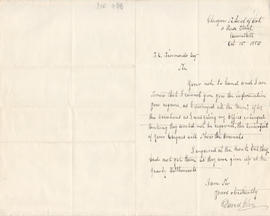
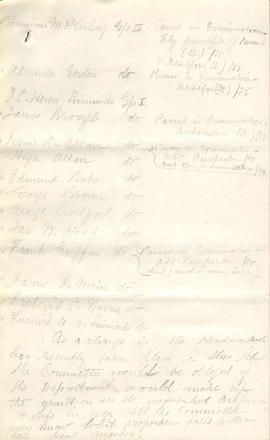
![Letter sent by Col. Donnelly [Science and Art Department Secretary] to GSA](/catalogue/uploads/r/gsa-archives/4/2/4/424c3731aef85f8945024cca3f43598e98bec219295a26b687da1c22e3106fe0/GSAA_DIR_0004_0030_142.jpg)
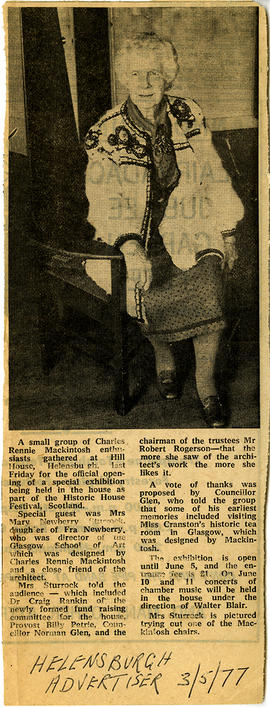
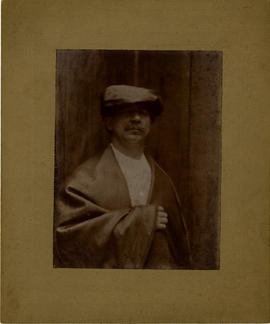
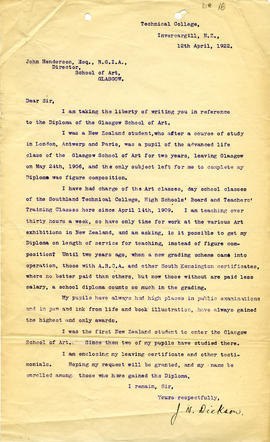

![Letter sent by Simmonds [from Derby School of Art] to Edward Catterns, GSA Secretary (Version 1)](/catalogue/uploads/r/gsa-archives/e/9/2/e924a29bea8790b557bdf2c79275ba86e380120e7237cefbe6901cbdbf725944/GSAA_DIR_0004_0011_v0001_142.jpg)
![Letter sent by Simmonds [from Derby School of Art] to Edward Catterns, GSA Secretary (Version 2)](/catalogue/uploads/r/gsa-archives/8/2/7/827bdd80a850af701d22874172455c933f0ba99ef6f2176c97d0d58d091643d7/GSAA_DIR_0004_0011_v0002_142.jpg)
![Letter sent by Simmonds [from Derby School of Art] to Edward Catterns, GSA Secretary (Version 1)](/catalogue/uploads/r/gsa-archives/f/d/7/fd76cb7c60334d1e6859af6ca2fab2fa029269e2dfbdbda0055a3e22f2f7c9fa/GSAA_DIR_0004_0012_v0001_142.jpg)
![Letter sent by Simmonds [from Derby School of Art] to Edward Catterns, GSA Secretary (Version 2)](/catalogue/uploads/r/gsa-archives/f/b/c/fbcf9ac7127755bad2b652034dae3a9ac022fe5ccd962b0c2ab2b7cd9f060aec/GSAA_DIR_0004_0012_v0002_142.jpg)
![Letter sent by Simmonds [from Derby School of Art] to Edward Catterns, GSA Secretary (Version 1)](/catalogue/uploads/r/gsa-archives/e/7/7/e77a60f7696ebd1a5afbcaf946d0864ae0e24da2ed53eb63b8a3ef7ab77aea5f/GSAA_DIR_0004_0013_v0001_142.jpg)
![Letter sent by Simmonds [from Derby School of Art] to Edward Catterns, GSA Secretary (Version 2)](/catalogue/uploads/r/gsa-archives/0/c/0/0c062897c4aec9706fb3e28a51b08816f9bce2deb547875b5c18c8668bd046c0/GSAA_DIR_0004_0013_v0002_142.jpg)
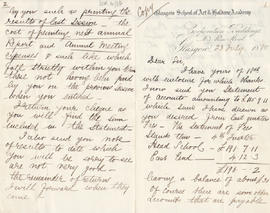

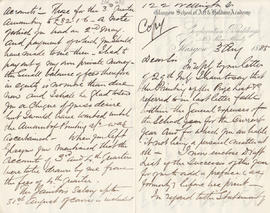
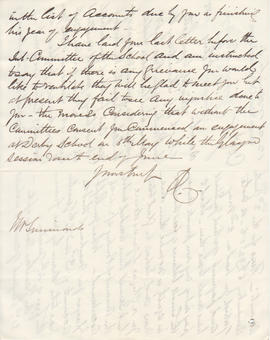
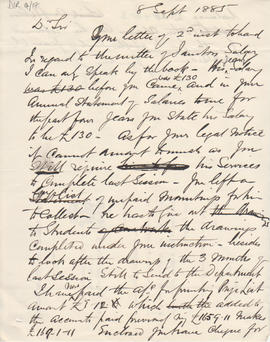
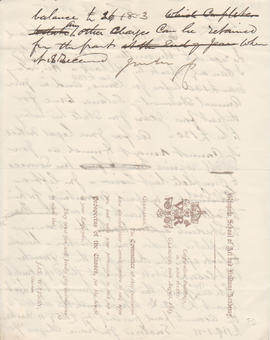
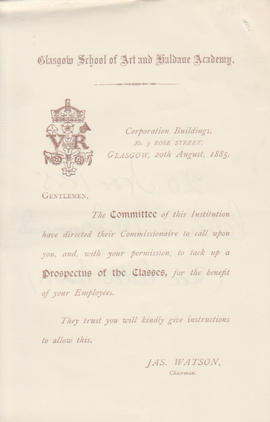
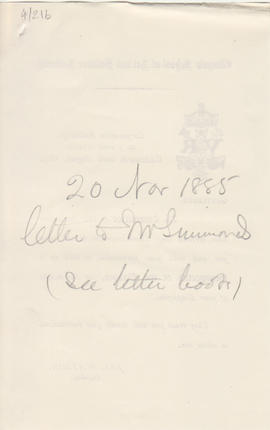
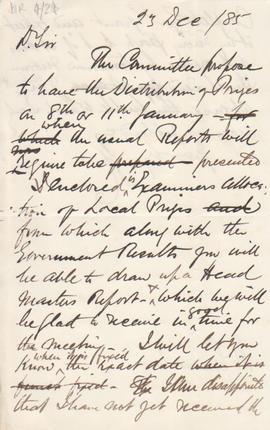
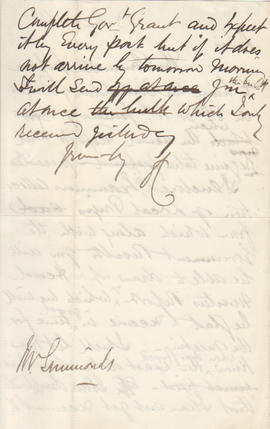
![Letter sent by A J R Trendall [Department of Science and Art] to GSA (Version 1)](/catalogue/uploads/r/gsa-archives/3/d/1/3d118392ff4331b385b925cbc6b52fc43f71a217cb888c3579e641bd8fe1cad5/GSAA_DIR_0004_0028_v0001_142.jpg)
![Letter sent by A J R Trendall [Department of Science and Art] to GSA (Version 2)](/catalogue/uploads/r/gsa-archives/c/4/3/c43ac985116e9619e41a65fbd7eb7986d90d3af0cd62270352379a3443414784/GSAA_DIR_0004_0028_v0002_142.jpg)
![Letter sent by Simmonds [from Derby School of Art], to Edward Catterns, GSA Secretary (Version 1)](/catalogue/uploads/r/gsa-archives/0/c/0/0c0995a9a31a219824afcf612dea012ef0a8717923b9b918bd542832ed9b4dc1/GSAA_DIR_0004_0002_v0001_142.jpg)
![Letter sent by Simmonds [from Derby School of Art], to Edward Catterns, GSA Secretary (Version 2)](/catalogue/uploads/r/gsa-archives/d/6/e/d6eb75400b9dde41701fae4ef89c69043d27519d1b675a3b24e8ca61a2348366/GSAA_DIR_0004_0002_v0002_142.jpg)
![Letter sent by Simmonds [from Derby School of Art] to Edward Catterns, GSA Secretary (Version 1)](/catalogue/uploads/r/gsa-archives/3/d/9/3d904b4bf4c7bc74f7b985544cc80e02f398df605d36523d3f4c1bd7fc97728e/GSAA_DIR_0004_0003_v0001_142.jpg)
![Letter sent by Simmonds [from Derby School of Art] to Edward Catterns, GSA Secretary (Version 2)](/catalogue/uploads/r/gsa-archives/a/e/c/aec677a4a6a436cb8e29802dd14555b6b608f8e9b253e05c9597cc0a48a7c127/GSAA_DIR_0004_0003_v0002_142.jpg)
![Letter sent by Simmonds [from Derby School of Art] to Edward Catterns, GSA Secretary (Version 1)](/catalogue/uploads/r/gsa-archives/6/1/c/61ccefee6137d7da40f77effa49dc3555cf6576f875ff767ad2b1a7766648079/GSAA_DIR_0004_0004_v0001_142.jpg)
![Letter sent by Simmonds [from Derby School of Art] to Edward Catterns, GSA Secretary (Version 2)](/catalogue/uploads/r/gsa-archives/d/1/d/d1df09c0bce34adc7db1a443b6ab18eba7dc72b45956dcd79bd642ddb7d4d0ba/GSAA_DIR_0004_0004_v0002_142.jpg)
![Letter sent by Simmonds [from Derby School of Art] to Edward Catterns, GSA Secretary (Version 1)](/catalogue/uploads/r/gsa-archives/f/a/8/fa8b4d153547d4027d1654811cd7a4170095f159a594fadd17e566b7e745ff38/GSAA_DIR_0004_0006_v0001_142.jpg)
![Letter sent by Simmonds [from Derby School of Art] to Edward Catterns, GSA Secretary (Version 2)](/catalogue/uploads/r/gsa-archives/0/9/5/095454c286fbc51b01865db1388a7664ff9f795b432082cc3e6157bb51302c79/GSAA_DIR_0004_0006_v0002_142.jpg)
![Letter sent by Simmonds [from Derby School of Art] to Edward Catterns, GSA Secretary (Version 1)](/catalogue/uploads/r/gsa-archives/f/d/6/fd670a897c8918af7d885871f6f1cb4517cd0f87b422d89ba2050c8c8eb27f8b/GSAA_DIR_0004_0007_v0001_142.jpg)
![Letter sent by Simmonds [from Derby School of Art] to Edward Catterns, GSA Secretary (Version 2)](/catalogue/uploads/r/gsa-archives/9/f/e/9feb2e0c246a27c24afb6ad8017f90f33220e49c25fc409b8cfa88649c139b6b/GSAA_DIR_0004_0007_v0002_142.jpg)
![Letter sent by Simmonds [from Derby School of Art] to Edward Catterns, GSA Secretary (Version 1)](/catalogue/uploads/r/gsa-archives/7/1/9/719bdc638bbbd49a65d05de90df239a9d29120f3b95afd0525d75cab45d9d800/GSAA_DIR_0004_0008_v0001_142.jpg)
![Letter sent by Simmonds [from Derby School of Art] to Edward Catterns, GSA Secretary (Version 2)](/catalogue/uploads/r/gsa-archives/1/1/f/11f27efc9501ebd07f5394f29251552ec22c6ae09bf134ddd867b3df6c84dd2d/GSAA_DIR_0004_0008_v0002_142.jpg)
![Letter sent by Simmonds [from Derby School of Art] to Edward Catterns, GSA Secretary (Version 1)](/catalogue/uploads/r/gsa-archives/4/b/b/4bb0d23a7ec22db144b143fe0e9f87b0f566643efeb438555bbe83527c4f1e0d/GSAA_DIR_0004_0009_v0001_142.jpg)
![Letter sent by Simmonds [from Derby School of Art] to Edward Catterns, GSA Secretary (Version 2)](/catalogue/uploads/r/gsa-archives/a/6/5/a6571e50e2a39c25aad32343cbbd1ced3163fb68f24c45a10e38a204ff480409/GSAA_DIR_0004_0009_v0002_142.jpg)
![Letter sent by Simmonds [from Derby School of Art] to Edward Catterns, GSA Secretary (Version 3)](/catalogue/uploads/r/gsa-archives/3/5/b/35b4f079b8c29480cd9a64ef9a3caee0bf00efa5c2b16e76807f2a1a21fa844f/GSAA_DIR_0004_0008_v0003_142.jpg)
![Letter sent by Simmonds [from Derby School of Art] to Edward Catterns, GSA Secretary (Version 4)](/catalogue/uploads/r/gsa-archives/c/d/3/cd3a62ee4e8c4d892680450c277655a3c16ee896e25705d1282c01cec1b94ded/GSAA_DIR_0004_0008_v0004_142.jpg)
